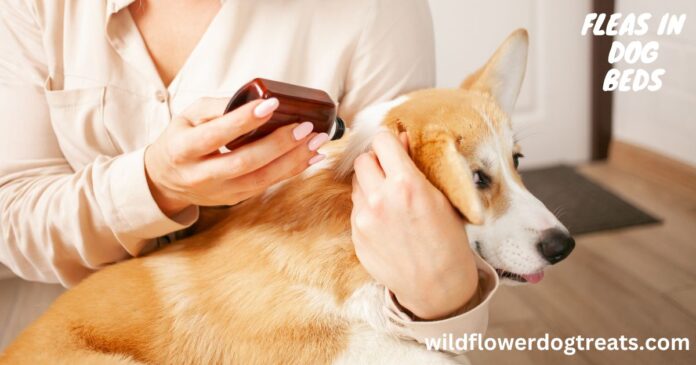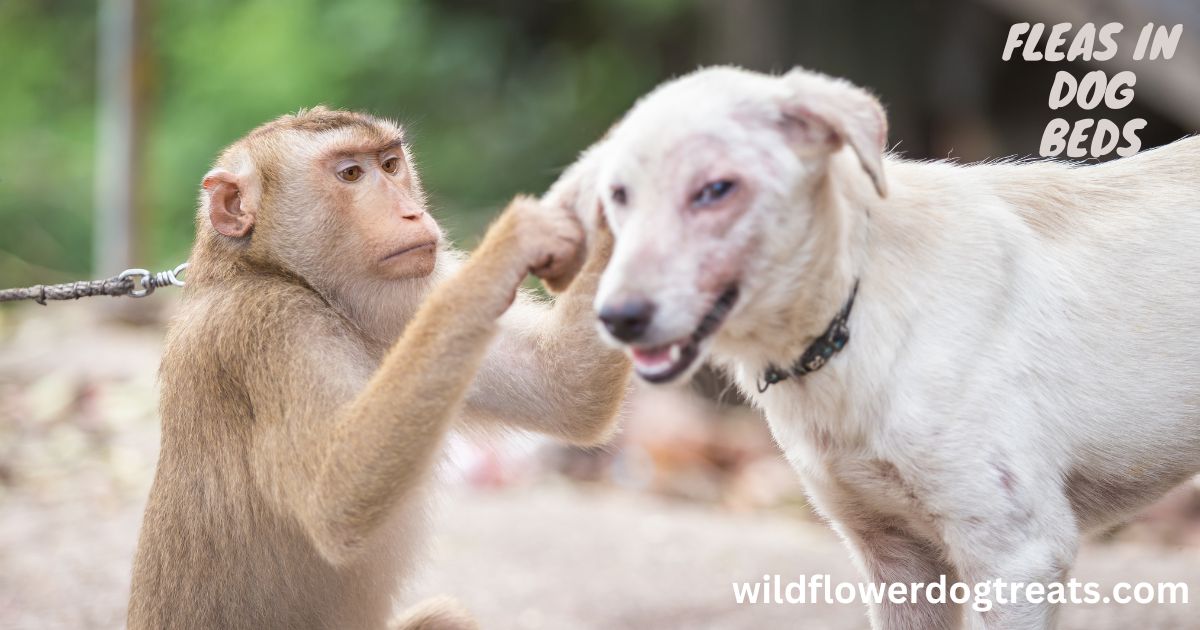Yes, fleas can live in dog beds. They thrive in warm environments and feed off pet dandruff and debris, making pet beds the perfect breeding ground for fleas.
It’s important to regularly clean and sanitize your dog’s bedding to prevent flea infestations and keep your pet healthy and comfortable. Dog beds can become a haven for fleas, posing a threat to your pet’s health and creating a nuisance in your home.
Fleas thrive in warm environments and feed off pet dandruff, creating an ideal breeding ground in dog beds. Regular cleaning and sanitization of your pet’s bedding is essential to prevent flea infestations and ensure a healthy living environment for your furry friend. Taking proactive measures to keep your pet’s bed flea-free will contribute to their overall well-being and comfort.
Flea Invasion In Canine Quarters
Fleas can live and thrive in dog beds, posing a threat to your canine friend’s comfort. It’s crucial to regularly clean and disinfect pet bedding to prevent flea infestations and keep your furry companion healthy and itch-free. Regular washing in hot, soapy water helps eliminate fleas, eggs, and larvae, ensuring a clean sleeping environment for your dog.
Unveiling The Reality Of Flea Infestation In Dog’s Sleeping Spaces
Flea infestation in a dog’s sleeping area is a serious concern that goes beyond the itchy nuisance they pose to our beloved pets. While many pet owners focus on treating their dogs for fleas, the often overlooked area is where these pests find refuge and continue to thrive – the dog’s bedding. Understanding how fleas can invade and persist in these spaces is crucial in effectively combating their infestation.
Understanding Fleas’ Lifecycles And Habits For Effective Prevention
To effectively prevent flea infestation in your dog’s sleeping quarters, it’s essential to understand the lifecycles and habits of fleas. Contrary to popular belief, fleas don’t just live on dogs – they particularly thrive in their cozy sleeping areas. Understanding their reproductive cycle, preferred habitat, and feeding habits will provide valuable insight into how to disrupt their life cycle and prevent infestation.
Identifying Signs Of Fleas
Fleas can live in dog beds and are commonly identified by the itchy bites and visible presence of small, dark insects. Regularly washing and cleaning your dog’s bedding helps eliminate fleas and their eggs and larvae, preventing infestations and keeping your pet healthy and comfortable.
It’s crucial to maintain a clean and flea-free environment for your furry friend’s well-being.
Spotting Flea Dirt And Physical Presence
One of the telltale signs of fleas is the presence of flea dirt, which may appear as small black specks on your pet’s bedding or fur. When placed on a damp paper towel, flea dirt will produce a reddish-brown stain due to the digested blood. Additionally, the physical presence of fleas on your dog’s bed, particularly in areas where your pet spends a lot of time, is a clear indicator of infestation.
Recognizing Unusual Dog Behaviors That Indicate Infestation
Pay attention to your dog’s behavior as unusual scratching, biting, or licking can indicate the presence of fleas. Your dog may also exhibit restlessness or unease, often due to the discomfort caused by flea bites. Excessive grooming, particularly in specific areas of the body, can be a sign of fleas. If you notice these behaviors, it’s important to thoroughly inspect your dog’s bed and fur for fleas and their debris.
Can Fleas Thrive In Dog Beds?
It’s a common concern among pet owners: can fleas really thrive in dog beds? Unfortunately, the answer is a resounding yes. Dog beds provide an optimal environment for fleas to breed and create a frustrating infestation for both pets and their owners. Understanding the suitability of dog beds for flea habitation and strategies for assessing infestation levels in canine bedding is crucial for effective flea control.
Exploring The Suitability Of Dog Beds For Flea Habitation
Fleas thrive in warm and cozy environments, and dog beds provide the perfect conditions for these pesky parasites to prosper. Their larvae feed off pet dandruff and adult flea feces, making pet bedding an ideal breeding ground for fleas. Understanding the factors that contribute to flea habitation in dog beds is essential for preventing infestations and keeping pets healthy.
Strategies For Assessing Infestation Levels In Canine Bedding
- Regularly inspect the dog bed for signs of fleas, including adult fleas, flea dirt, and eggs.
- Use a flea comb to comb through the dog’s fur and inspect for any signs of fleas or flea dirt.
- Wash the bedding thoroughly in hot, soapy water to kill fleas and destroy their eggs and larvae.
- Consider using flea prevention products to protect the dog and its bedding from infestations.
By implementing these strategies, pet owners can effectively assess and manage infestation levels in their canine bedding, ensuring a clean and comfortable environment for their furry companions.
Flea-proofing Your Dog’s Bed
In order to provide your furry friend with a comfortable and safe resting place, it’s essential to flea-proof your dog’s bed. Fleas can easily infest your dog’s sleeping area, causing discomfort and potential health issues. Implementing proper flea prevention measures not only safeguards your pet but also maintains a clean and hygienic environment in your home. Below, we will cover essential strategies to effectively flea-proof your dog’s bed.
Selection Of Appropriate Bedding Materials
When flea-proofing your dog’s bed, the choice of bedding materials plays a crucial role. Opt for materials that are less hospitable to fleas, such as:
- Waterproof materials: Choose bedding with a waterproof layer to prevent fleas from nesting and thriving in damp environments.
- Elevated or raised beds: Elevated beds provide effective ventilation and make it challenging for fleas to infest the sleeping area.
- Tightly woven fabrics: Select bedding with tightly woven fabrics that discourage flea intrusion and are easier to clean.
Regular Cleaning Rituals And Techniques
Maintaining a clean and flea-free environment for your pet involves regular cleaning rituals and techniques. Implement the following cleaning practices to prevent flea infestations:
- Regular laundering: Wash and clean your dog’s bedding regularly with hot water and pet-safe detergent to eliminate fleas, their eggs, and larvae.
- Vacuuming: Vacuum the surrounding area of the dog bed and other potential flea hotspots to remove any lingering fleas and their eggs.
- Sun exposure: Periodically expose the bedding to direct sunlight to help naturally eliminate fleas and maintain a dry environment.
Safe Use Of Flea Repellents And Insecticide Products
When employing flea repellents and insecticide products, it’s crucial to ensure their safe use to protect both your pet and the environment. Consider the following tips for utilizing flea control products:
- Consult a veterinarian: Seek guidance from a veterinarian to select safe and effective flea repellents suitable for your pet’s bed.
- Read and follow instructions: Adhere to the instructions provided with flea repellents and insecticides to prevent harmful exposure to your pet and family members.
- Spot treatment: Use targeted flea control products specifically designed for pet bedding, ensuring they are safe for your dog’s health.
Fleas Begone: Regular Maintenance
Regular maintenance is key to keeping your dog’s bed free from fleas. Implementing a routine for controlling flea populations, using vet-approved flea treatment plans, and creating a flea-free home environment are essential aspects of keeping your pet safe and healthy.
Implementing A Routine For Controlling Flea Populations
Regularly washing your dog’s bed and bedding in hot, soapy water is crucial for controlling flea populations. This should be done once a week to kill fleas and destroy their eggs and larvae. Consistent vacuuming of the area where your dog’s bed is placed can also help remove any lingering fleas and prevent infestations. Additionally, consider using flea repellent products with natural ingredients to keep fleas at bay.
Importance Of Vet-approved Flea Treatment Plans
Seek advice from your veterinarian to create a vet-approved flea treatment plan for your dog’s specific needs. This may include topical or oral flea treatments, which are effective in killing and preventing fleas. Following a vet’s recommendation is crucial to ensure the safety and well-being of your pet.
Considerations For A Flea-free Home Environment
Aside from regular washing and vacuuming, consider implementing flea prevention measures throughout your home. This may involve using essential oils with flea-repelling properties, maintaining a clean and clutter-free living space, and avoiding exposure to areas with known flea infestations. By creating a flea-free environment, you can minimize the risk of infestations and ensure a healthy living space for both your pet and your family members.
Frequently Asked Questions For Can Fleas Live In Dog Beds
How Do You Get Rid Of Fleas In Dog Bed?
To get rid of fleas in a dog bed, wash the bedding in hot, soapy water to kill fleas and their eggs. Ask your vet for recommendations. For heavy infestations, it’s best to replace the bedding. Regular washing can keep the bedding free from insects.
How Long Can Fleas Live On Dog Bed?
Fleas can live on a dog bed for up to 5 months if not treated. Regular hot, soapy washing can help eliminate fleas and their eggs.
Should I Throw Away My Dogs Bed If He Has Fleas?
If your dog’s bed has fleas, it’s best to discard it to ensure the fleas are eliminated. Regularly bathe the dog and wash its bedding with hot, soapy water to control the fleas. Vacuum and treat your home to prevent re-infestation.
Can My Dog Sleep In My Bed With Fleas?
Yes, but it’s not advisable. Fleas can transfer from your dog to you, causing itching and discomfort.
Conclusion
Fleas can indeed live in dog beds, creating a potential nuisance for both your pet and your household. To prevent infestations, it’s crucial to regularly clean and treat your dog’s bedding. By taking proactive measures, such as washing the bedding frequently and seeking veterinary advice, you can effectively control and eliminate flea populations in your dog’s sleeping area.




